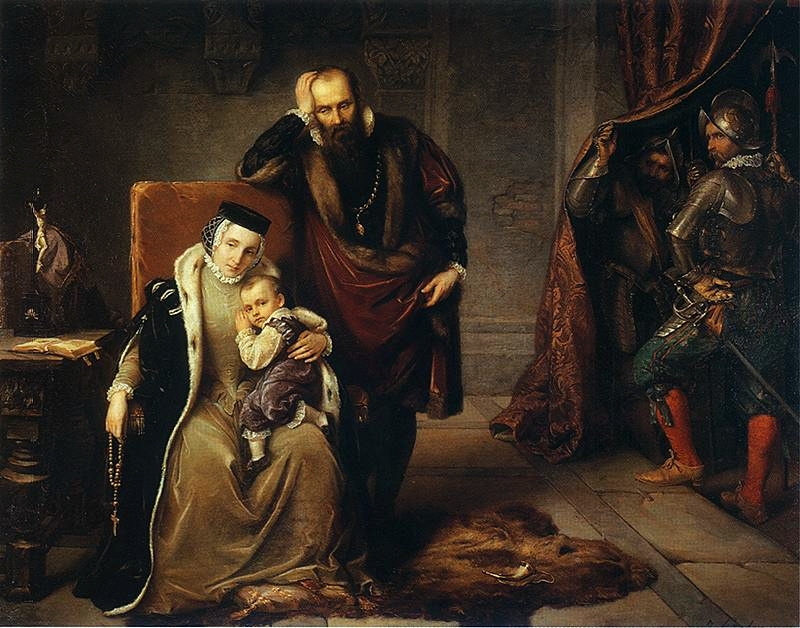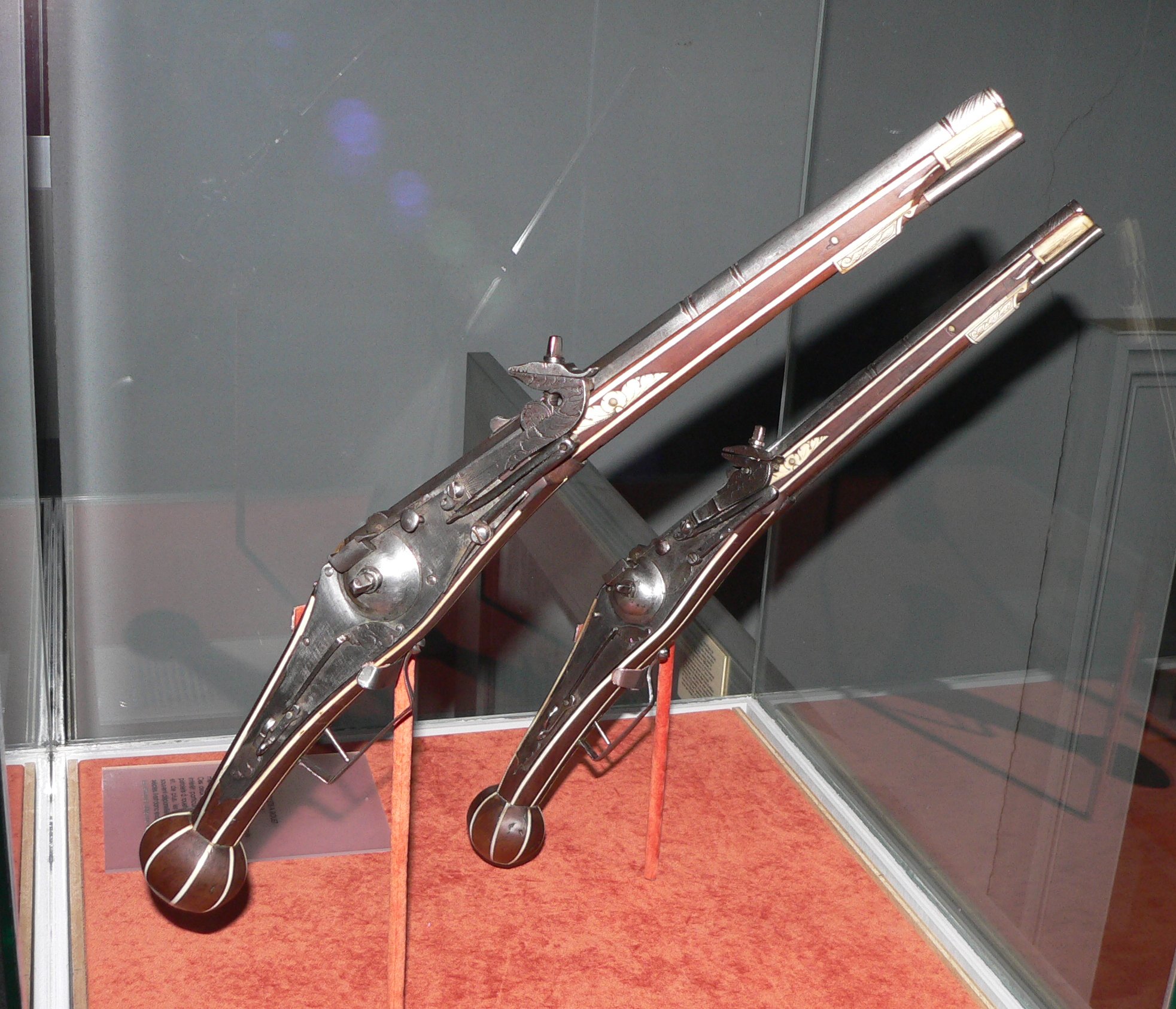|
Battle Of Tczew
The Battle of Dirschau (also known as Battle of Tczew) took place in the summer of 1627 (17â18 August) and was one of the battles of the PolishâSwedish War (1626â29). The Polish forces led by Crown Field Hetman StanisĆaw Koniecpolski met with troops commanded by Swedish King Gustavus Adolphus of Sweden. Gustavus Adolphus was wounded in the battle, which ended inconclusively. Fighting in Prussia ended in a stalemate for that year, and would not resume until 1628. Background In the summer of 1626 the Swedes invaded Pomerania and the Duchy of Prussia, taking Pillau (Baltiysk, PiĆawa). The fighting spread, marked by a number of Swedish successes that year against the forces of the Polish king Sigismund III Vasa. In October, the Polish forces in the region were reinforced by the army of Crown Field Hetman StanisĆaw Koniecpolski, relocated from the south-eastern border of the PolishâLithuanian Commonwealth. Koniecpolski was able to slow down the Swedes and retake some ter ... [...More Info...] [...Related Items...] OR: [Wikipedia] [Google] [Baidu] |
Sigismund III Vasa
Sigismund III Vasa ( pl, Zygmunt III Waza, lt, Ćœygimantas Vaza; 20 June 1566 â 30 April 1632 Adoption of the Gregorian calendar, N.S.) was King of Poland and Grand Duke of Lithuania from 1587 to 1632 and, as Sigismund, King of Sweden and Grand Duke of Finland from 1592 to 1599. He was the first Polish sovereign from the House of Vasa. Religiously zealous, he imposed Roman Catholicism across the vast realm, and his crusades against neighbouring states marked Poland's largest territorial expansion. As an enlightened despot, he presided over an era of Polish Golden Age, prosperity and achievement, further distinguished by the transfer of the country's capital from KrakĂłw to Warsaw. Sigismund was the son of King John III of Sweden and his first wife, Catherine Jagiellon, daughter of King Sigismund I of Poland. Elected monarch of the PolishâLithuanian Commonwealth in 1587, he sought to unify Poland and Sweden under one Catholic kingdom, and when he succeeded his deceased fat ... [...More Info...] [...Related Items...] OR: [Wikipedia] [Google] [Baidu] |
Battle Of Oliwa
The Battle of Oliwa, also known as the Battle of Oliva or the Battle of GdaĆsk Roadstead, was a naval battle that took place on 28 November, 1627, slightly north of the port of Danzig off of the coast of the village of Oliva during the PolishâSwedish War. It was the largest naval engagement to be fought by the PolishâLithuanian Commonwealth Navy and resulted in defeating a Swedish squadron led by Niels Stiernsköld that conducted a blockade of the harbour of Danzig. The Poles sailed out of the Danzig harbour and engaged the Swedish squadron capturing the Swedish flagship and sinking another Swedish warship.Frost, R.I., 2000, ''The Northern Wars, 1558â1721'', Harlow: Pearson Education Limited, Background The Swedes had a long tradition of seamanship and maintained a strong navy, and were able to land troops from the Swedish mainland at will along the southern Baltic shore. They were also able to blockade the PolishâLithuanian Commonwealth's ports (most important bei ... [...More Info...] [...Related Items...] OR: [Wikipedia] [Google] [Baidu] |
Rokitki, Tczew County
Rokitki (german: Rokittken, 1942â45 Rokitten) is a village in the administrative district of Gmina Tczew, within Tczew County, Pomeranian Voivodeship, in northern Poland. It lies approximately south-east of Tczew and south of the regional capital GdaĆsk. It is located within the ethnocultural region of Kociewie in the historic region of Pomerania. The village was previously known as Reisicht. The village has a population of 1,900. History The name of the village comes from a willow species, known in Polish as ''wierzba rokita''. Rokitki was a royal village of the Polish Crown, administratively located in the Tczew County in the Pomeranian Voivodeship. The Battle of Tczew during the PolishâSwedish War (1626â1629) was fought nearby in August 1627. During the German occupation of Poland (World War II), in 1939, local Polish activist PaweĆ Miller was murdered by the Germans in the SzpÄgawski Forest along with several Poles from other villages (see ''Intelligenzaktion'' ... [...More Info...] [...Related Items...] OR: [Wikipedia] [Google] [Baidu] |
Swedish Cavalry
This is a list of Swedish cavalry regiments, battalions, corps and companies that have existed in the Sweden, Swedish Swedish Army, Army. They are listed in three ways, first by the actual units that have existed, then by the various names these units have had, and last by the various designations these units have had. By unit * Adelsfanan (1571–1901) * Aschebergska regementet (1674–1720) * BlĂ„ (Putbusska) husarregemenetet (1762–1766) * Bohus dragonbataljon (1679–1720) * Bohus-JĂ€mtlands kavalleribataljon (1661–1670) * BohuslĂ€n Regiment, BohuslĂ€ns dragonregemente (1727–1776) * BohuslĂ€n Regiment, BohuslĂ€ns kavalleri- och dragonregemente (1720–1727) * BohuslĂ€ns kavallerikompani (1670–1674) * BohuslĂ€n Regiment, BohuslĂ€ns lĂ€tta dragonregemente (1776–1791) * Crown Prince's Hussar Regiment, Cederströmska husarregementet (1816–1822) * Finska lĂ€tta dragonkĂ„ren (1770–1772) * Gula (Wrangelska) husarregementet ... [...More Info...] [...Related Items...] OR: [Wikipedia] [Google] [Baidu] |
Levee
A levee (), dike (American English), dyke (Commonwealth English), embankment, floodbank, or stop bank is a structure that is usually earthen and that often runs parallel to the course of a river in its floodplain or along low-lying coastlines. The purpose of a levee is to keep the course of rivers from changing and to protect against flooding of the area adjoining the river or coast. Levees can be naturally occurring ridge structures that form next to the bank of a river, or be an artificially constructed fill or wall that regulates water levels. Ancient civilizations in the Indus Valley, ancient Egypt, Mesopotamia and China all built levees. Today, levees can be found around the world, and failures of levees due to erosion or other causes can be major disasters. Etymology Speakers of American English (notably in the Midwest and Deep South) use the word ''levee'', from the French word (from the feminine past participle of the French verb , 'to raise'). It originated ... [...More Info...] [...Related Items...] OR: [Wikipedia] [Google] [Baidu] |
MotĆawa
MotĆawa (; csb, MĂČtĆawa) is a river in Eastern Pomerania in Poland. The source is in SzpÄgawskie Lake, northeast from the town of Starogard GdaĆski. It goes through Rokickie Lake to Martwa WisĆa, a branch of the Vistula. The total length of the river is estimated at 68 km, with an area of 1511.3 kmÂČ. The city of GdaĆsk is situated at its mouth in the Martwa WisĆa. In GdaĆsk, the MotĆawa ferry crosses the river, a service that has run since the year 1687. History The Polish name ''MotĆawa'' is derived from the Old Prussian language. In German the river is known as ''Mottlau''. A common theory for the etymology of the cities GdaĆsk and Gdynia Gdynia ( ; ; german: Gdingen (currently), (1939â1945); csb, GdiniĂŽ, , , ) is a city in northern Poland and a seaport on the Baltic Sea coast. With a population of 243,918, it is the List of cities in Poland, 12th-largest city in Poland and ... is that they are named after an older Polish and Kashubian name ... [...More Info...] [...Related Items...] OR: [Wikipedia] [Google] [Baidu] |
Herman Wrangel
Herman Wrangel (born 1584/1587 â 10 December 1643) was a Swedish military officer and politician of Baltic German extraction. Biography Herman von Wrangel was born in Livonia. He came to Sweden around 1608. In 1612, he participated in the Kalmar War against Denmark. In 1619, Wrangel was commander of Ălvsborg fortress. He was appointed Field Marshal in 1621, Privy Councillor in 1630, and Governor General of Swedish Livonia in 1643. Wrangel was married three times. In 1636, he married Amalie of Nassau-Siegen, daughter of John VII, Count of Nassau-Siegen Count John VII âthe Middleâ of Nassau-Siegen (7 June 1561 â 27 September 1623), german: Johann VII. âder Mittlereâ Graf von Nassau-Siegen, official titles: ''Graf zu Nassau, Katzenelnbogen, Vianden und Diez, Herr zu .... He was the father of statesman and military commander Carl Gustaf von Wrangel (1613â1676). See also * Wrangel family * Polish-Swedish War References Other Sources W ... [...More Info...] [...Related Items...] OR: [Wikipedia] [Google] [Baidu] |
JindĆich MatyĂĄĆĄ Thurn
Count JindĆich MatyĂĄĆĄ of Thurn-Valsassina (german: Heinrich Matthias Graf von Thurn und Valsassina; it, Enrico Matteo Conte della Torre di Valsassina) (24 February 1567 â 26 January 1640), was one of the leaders of the Protestant Bohemian Revolt against Emperor Ferdinand II. He took part in events that led to the Thirty Years' War, and after the war he became a military leader and diplomat in Swedish service, who eventually resided in Swedish Estonia. Life He was the son of a member of the '' geheimrat'' of Ferdinand II, Archduke of Austria, Franz Napus von Thurn und Valsassina (FrantiĆĄek Thurn), count of Linz (1508â1586) and his second wife, Countess Barbora GrĂ€fin von Schlick (1547â1581), daughter of Count Hieronymus Schlick of Bassano and WeiĂkirchen and countess Katharina von Gleichen-Tonna. Both of his parents were Protestants. Count JindĆich MatyĂĄĆĄ was born on in Lipnice nad SĂĄzavou castle in the Crown of Bohemia. After the death of his father ... [...More Info...] [...Related Items...] OR: [Wikipedia] [Google] [Baidu] |
Cossack
The Cossacks , es, cosaco , et, Kasakad, cazacii , fi, Kasakat, cazacii , french: cosaques , hu, kozĂĄkok, cazacii , it, cosacchi , orv, ĐșĐŸĐ·Đ°ÌĐșĐž, pl, Kozacy , pt, cossacos , ro, cazaci , russian: ĐșĐ°Đ·Đ°ĐșĐžÌ or , sk, kozĂĄci , uk, ĐșĐŸĐ·Đ°ĐșĐžÌ are a predominantly East Slavic Orthodox Christian people originating in the PonticâCaspian steppe of Ukraine and southern Russia. Historically, they were a semi-nomadic and semi-militarized people, who, while under the nominal suzerainty of various Eastern European states at the time, were allowed a great degree of self-governance in exchange for military service. Although numerous linguistic and religious groups came together to form the Cossacks, most of them coalesced and became East Slavic-speaking Orthodox Christians. The Cossacks were particularly noted for holding democratic traditions. The rulers of the Polish-Lithuanian Commonwealth and Russian Empire endowed Cossacks with certain ... [...More Info...] [...Related Items...] OR: [Wikipedia] [Google] [Baidu] |
Reiter
''Reiter'' or ''Schwarze Reiter'' ("black riders", anglicized ''swart reiters'') were a type of cavalry in 16th to 17th century Central Europe including Holy Roman Empire, PolishâLithuanian Commonwealth, Tsardom of Russia, and others. Contemporary to the cuirassier and lancer cavalry, they used smaller horses, for which reason they were also known as ''Ringerpferde'' (corresponding to the French '' Argoulets''). They were originally recruited in the North German Plain west of the Oder at the time of the Schmalkaldic War of 1546/7. The Reiter raised firearms to the status of primary weapons for cavalry, as opposed to earlier Western European heavy cavalry which primarily relied upon melee weapons. A Reiter's main weapons were two or more pistols and a sword; most Reiters wore helmets and cuirasses and often additional armor for the arms and legs; sometimes they also carried a long cavalry firearm known as an arquebus or a carbine (although this type of horsemen s ... [...More Info...] [...Related Items...] OR: [Wikipedia] [Google] [Baidu] |
Hussar
A hussar ( , ; hu, huszĂĄr, pl, husarz, sh, husar / ) was a member of a class of light cavalry, originating in Central Europe during the 15th and 16th centuries. The title and distinctive dress of these horsemen were subsequently widely adopted by light cavalry regiments in European armies in the late 17th and early 18th centuries. By the 19th century, hussars wore jackets decorated with braid and shako or busby hats and they developed a romanticized image of being dashing and adventurous. A small number of modern armies retain the designation of hussars for some armored (tank) units. As well, some modern armies have ceremonial mounted units which wear historical hussar uniforms on parades or to provide a VIP escort to national leaders. Historically, the term derives from the cavalry of late medieval Hungary, under Matthias Corvinus, with mainly Serb warriors. Etymology Etymologists are divided over the derivation of the word ''hussar''. Several alternative theorie ... [...More Info...] [...Related Items...] OR: [Wikipedia] [Google] [Baidu] |




